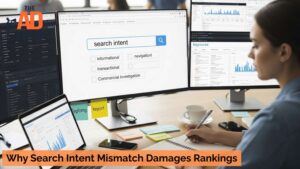Your go-to SEO tactics may no longer be enough. Today’s search results feature AI-generated summaries that provide users with quick answers at the top of the page. These AI Overviews don’t just highlight one source; they combine insights from multiple websites in seconds.
In this guide, we’ll walk you through what AI Overviews are, how they impact your visibility in search, and how to adapt your content, especially if you rely on local SEO services, so it actually shows up.
What Are Google’s AI Overviews?
Google’s AI Overviews are short, conversational summaries that appear at the very top of search results. When users ask a complex question, Google’s AI pulls information from multiple sources to answer it in a single, easy-to-read block.
This differs from featured snippets, which typically extract a single sentence from a webpage. They combine information from various sources into a single, streamlined response.
What makes this important?
These summaries now show before the usual organic listings. Even well-written content can be skipped if the AI doesn’t see it as useful or clear enough to include. If your page lacks structure, credibility, or relevance, it is unlikely to make the cut.
How to Optimize Your Content for AI Overviews
If you want your site to show up in Google’s AI Overviews, traditional SEO tactics won’t be enough. As any experienced SEO agency knows, the AI generates summaries from content that’s structured clearly, written in plain language, and grounded in trustworthy expertise, rather than being stuffed with keywords.
Write Clear, Concise Answers to Common Questions
Google’s AI doesn’t have time to dig through clutter. It appears to look for short, concise answers that directly respond to common questions people search for.
- Use short, direct answers near the top of your content: Format a 2–3 sentence summary directly under each question or subheading. AI Overviews prioritize these concise responses that get to the point without unnecessary details. If your answer is buried under a long intro, the AI may skip it.
- Phrase responses using natural language: Write in a way that mirrors how real people speak and search. For example, say “A sitemap tells search engines what’s on your site” instead of “A sitemap is a critical XML protocol.” This makes your content easier for AI (and readers) to understand and summarize.
- Avoid fluff or vague explanations: Every word should add value, not just take up space. If your content feels repetitive or confusing, the AI won’t trust it as a good summary source. Keep each answer focused and helpful.
Use Subheadings That Match Search Intent
Subheadings aren’t just for organization; they help both readers and AI navigate your content. As any skilled digital marketing agency will tell you, when your headers mirror real search queries, your content becomes easier to parse and more likely to be chosen by Google’s AI.
Streamline Your Digital Assets with The Ad Firm
- Web Development: Build and manage high-performing digital platforms that enhance your business operations.
- SEO: Leverage advanced SEO strategies to significantly improve your search engine rankings.
- PPC: Craft and execute PPC campaigns that ensure high engagement and superior ROI.
- Use H2s and H3s that match what people are searching for: Replace vague titles like “Our Insights” with practical phrasing like “How to Improve Local SEO for Restaurants.” These keyword-aligned headers increase your visibility in both organic search and AI summaries. Think of your headers as signposts for both Google and your reader.
- Break down content into scannable sections: Organize your ideas by theme so that each section clearly addresses a single topic. When the AI encounters well-structured content, it can more effectively piece together relevant information for an Overview. Avoid long paragraphs with too many points jumbled together.
- Avoid clever or branded headers: Skip witty titles like “Boost Mode Activated.” They may look fun, but they give no clue what the section is about. Google’s AI prefers straightforward labels that enable it to categorize content efficiently.
Add Context, Not Just Keywords
AI Overviews don’t reward pages that repeat keywords; they reward pages that add value. The goal is to explain not just what something is, but why it matters and how it works.
- Offer purpose and practical relevance behind each concept: For instance, don’t just define schema markup, explain that it helps search engines understand your page better. That context tells the AI you’re offering insight, not just surface-level information. This makes your content more useful for summary material.
- Use real-world examples or comparisons: If you’re writing about internal linking, compare it to a table of contents in a book. These analogies make your point more relatable and easier to grasp. Plus, examples help the AI see how your content adds depth.
- Skip keyword stuffing at all costs: Repeating the exact phrase over and over is not only unhelpful; it can hurt readability. Instead, explain the concept in natural language with supporting context. The AI values easy-to-follow content over repetitive phrasing.
Cite Sources and Show Author Expertise
The AI needs to know your content is trustworthy. Clear attribution of authorship and sources is a best practice often emphasized in effective SEO services, which helps establish credibility and increases your chances of being featured in AI-generated summaries.
- Include expert bylines or bios where relevant: Add short bios that explain the author’s experience on the topic. For example, “Jane Smith, SEO Strategist with 10 years in local search,” helps build trust. This kind of transparency strengthens your E-E-A-T signals.
- Cite reputable sources when using facts or stats: Link out to well-known research, government data, or industry reports to support your claims. Google looks for verifiable information, and citations indicate to the AI that your content is grounded in evidence. Avoid using vague phrases like “research shows” without providing supporting evidence.
- Share original insight or experience: If you’ve run a test or used a tool personally, say so. These unique perspectives demonstrate that AI is not just copying content from elsewhere. That kind of authority is more complicated to fake and more likely to be rewarded.
Optimize for Conversational Phrasing
AI Overviews are trained on how people actually talk, not formal documents or corporate brochures. Your content should read like something a helpful expert would say to a curious customer.
Maximize Your Online Impact with The Ad Firm
- Local SEO: Capture the local market with strategic SEO techniques that drive foot traffic and online sales.
- Digital PR: Boost your brand’s image with strategic digital PR that connects and resonates with your audience.
- PPC: Implement targeted PPC campaigns that effectively convert interest into action.
- Mirror how users actually ask questions: Use phrasing that reflects real search habits, like “how to boost email open rates” or “why SEO takes time.” These naturally phrased queries help your content show up in summaries triggered by voice or typed searches. The more your language matches the way people think, the more visible you become.
- Avoid sounding too stiff or academic: Phrases like “a multifaceted framework” might look smart, but create a barrier. Keep your tone accessible without dumbing things down. If a business owner can’t understand it, AI will assume the average reader can’t either.
Read Also: How to Implement Generative Engine Optimization (GEO) Strategies
Mistakes That Can Lower Your AI Overview Visibility
Even strong content can be ignored by Google’s AI if it sends the wrong signals. These common missteps can reduce your chances of being featured, even if your content is accurate or well-intended.
- Over-optimizing with robotic or keyword-heavy content: AI Overviews are designed to mimic how people speak and ask questions. When content is stuffed with keywords or reads like a machine wrote it, it loses that natural tone Google is looking for. Instead of helping with ranking, it may actually signal low quality and be skipped entirely.
- Ignoring user intent: If your content doesn’t actually answer what people are asking, it won’t be pulled into an AI Overview. Google is trained to identify responses that are contextually relevant, not just vaguely related. It’s critical to understand what the searcher wants to know and respond directly to that.
- Using vague or fluffy copy with no clear takeaway: AI looks for content with substance, not filler. If your page is full of general statements that don’t offer specifics, clarity, or actionable insights, the AI has nothing solid to pull from. That can result in your content being ignored, even if it ranks well elsewhere.
- Failing to establish trustworthiness: Google prioritizes trustworthy sources in its AI summaries. If your content lacks author names, bios, or publication dates, it may be flagged as unreliable. Outdated information or unsourced claims can also lower your chances of selection, no matter how well-written the content is.
Let The Ad Firm Help You Stay Visible in AI-Driven Search
AI Overviews are reshaping how Google displays information, and that means your SEO strategy needs to evolve as well. At The Ad Firm, we help businesses stay ahead of Google’s changes with smart content strategies, real-time optimization, and effective technical SEO.
Boost Your Business Growth with The Ad Firm
- PPC: Optimize your ad spends with our tailored PPC campaigns that promise higher conversions.
- Web Development: Develop a robust, scalable website optimized for user experience and conversions.
- Email Marketing: Engage your audience with personalized email marketing strategies designed for maximum impact.
We specialize in SEO services tailored for today’s algorithms, not those of yesterday. From structuring your content for clarity to aligning with E-E-A-T signals and user intent, we ensure your pages are optimized for visibility across both traditional rankings and Google’s AI-generated summaries.
If you’re not sure how your content stacks up in this new search environment, as a top SEO company, we’re here to help. Let’s discuss how we can future-proof your SEO strategy, ensuring your business remains visible where it matters most.
Contact us today to get started.





